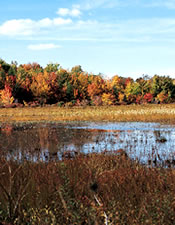Siberian Bogs Contain Global Warming
 Vast peatbogs in Russia's north are very important for regulation of greenhouse gases in the atmosphere all over the world
Vast peatbogs in Russia's north are very important for regulation of greenhouse gases in the atmosphere all over the world
The Siberian bogs became large methane producers soon after the last glacial period that ended about 12,000 years ago, which is much earlier that scientists traditionally believed. Researchers from the University of California have also discovered evidence proving that peatbogs are the largest carbon depositories in the world that absorb much carbon dioxide from the atmosphere. Both are greenhouse gases. They absorb long wavelength radiation and stop heat in the low layers of the earthly atmosphere. This means Russia's north will play an important role in prospective warming.
Glen McDonald and his colleagues studied Russia's West-Siberian plain covering the area of 1.3 million square kilometers, the most extensive peatbog system in the world. Radiocarbon measurements have revealed that the peatbogs are 2-3 thousand years older than was traditionally believed; researchers believe the peatbogs caused the sudden rise in methane content in the atmosphere which occurred 9-11.5 thousand years ago as seen from the Arctic ice probes. Earlier, the sudden rise was explained with large-scale discharges from the sea bottom and rainforests.
Peat forms in cold damp areas, especially in the northern latitudes where plants cannot decompose completely. Peat gets accumulated in the course of time and forms layers that may be thousands of years old. When the soil is rich in water and contains little oxygen, methane producing anaerobic bacteria try to absorb organic substances.
Deep peat probes (a peat layer may be ten and more meters deep) demonstrate that other species were dominating in lowlands at those periods, they produced six times more methane as compared with modern species such as sphagnum. However, these peatbogs catch carbon dioxide, turn it into harmless carbon and keep it under the surface. As plants do not decompose in peatbogs completely, the major part of carbon dioxide absorbed with plants never gets back to the air.
Estimations demonstrate that peatbogs of Russia's West-Siberian plain contain from 7 to 26 per cent of the global carbon reserves that accumulated after the last glacial epoch. Peatbgos of the whole of the world contain about 550 billion tons of carbon. The situation will be particularly dramatic if this amount of carbon will get back to the atmosphere as carbon dioxide. Some processes going on in the northern Siberia demonstrate that this may start soon.
Ice is melting in the Arctic. Bushes spread into the tundra, and the northern limitation of trees growth may follow further as well. Researches reveal that the permafrost ruins along its southern borders while its temperature increases in the north. These apprehensions concern other countries as well.
The rise in temperature together with melting of the permafrost and lowering of the underground water level may result in microbial decomposition because of higher oxygen content in the soil. If so, then carbon dioxide will evolve instead of methane. According to modeling results, carbon dioxide has higher heating potential than methane, NTR.Ru reports.
Subscribe to Pravda.Ru Telegram channel, Facebook, RSS!





